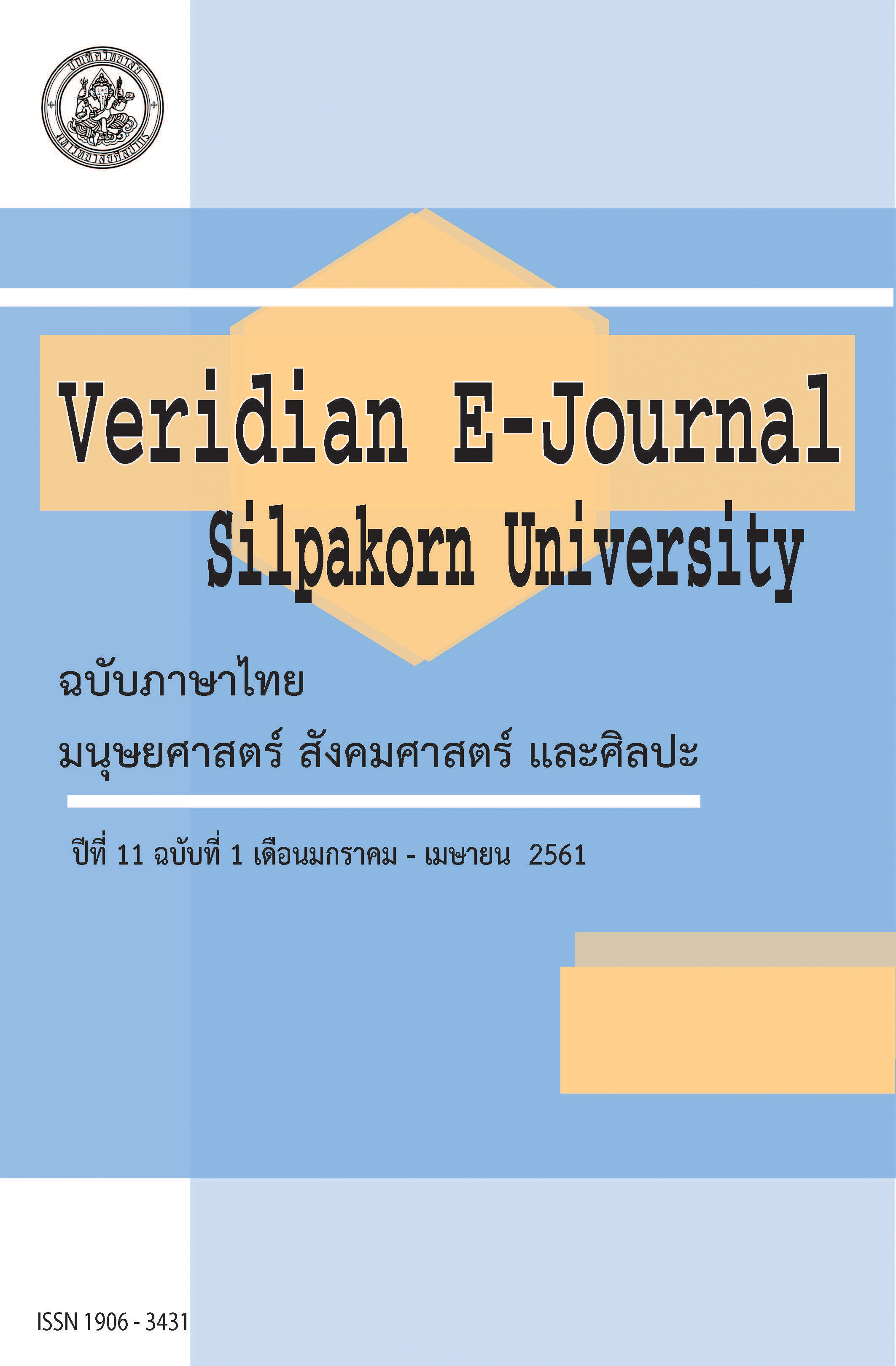การเพิ่มศักยภาพทางการสื่อสารรณรงค์เรื่องการรู้เท่าทันสื่อในกลุ่มผู้สูงอายุอำเภอเชียงคำ จังหวัดพะเยา (The increasing of communication proficiency to promote the media literacy in the elderly, Chiang Kum District, Phayao Province
Main Article Content
Abstract
การศึกษาครั้งนี้มีวัตถุประสงค์เพื่อ 1) วิเคราะห์กระบวนการเพิ่มศักยภาพทางการสื่อสารรณรงค์เรื่องการรู้เท่าทันสื่อในกลุ่มผู้สูงอายุอำเภอเชียงคำ จังหวัดพะเยา 2) ประเมินผลการสื่อสารรณรงค์เรื่องการรู้เท่าทันสื่อ การวิจัยครั้งนี้ใช้วิธีการวิจัยเชิงปฏิบัติการ เก็บรวบรวมข้อมูลด้วยการสำรวจพื้นที่ สนทนากลุ่ม สัมภาษณ์ เชิงลึก และการประชุมเชิงปฏิบัติการกับกลุ่มผู้ให้ข้อมูลหลัก ได้แก่ คณะกรรมการผู้สูงอายุประจำตำบล อาสาสมัครทางการสื่อสาร และภาคีเครือข่าย คือ กลุ่มอาสาสมัครสาธารณสุขประจำหมู่บ้าน(อสม.) นักวิชาการของเทศบาลตำบลเวียง และโรงพยาบาลส่งเสริมสุขภาพประจำตำบล
ผลการศึกษาพบว่า ก่อนการเพิ่มศักยภาพการสื่อสารฯ ผู้สูงอายุในชุมชนมีศักยภาพตามองค์ประกอบการสื่อสาร ดังนี้ 1) ผู้ส่งสารหลักในชุมชนเป็นผู้ที่ได้รับการยอมรับศรัทธาจากผู้รับสาร ทั้งผู้ส่งสารที่เป็นผู้นำชุมชนแบบเป็นทางการและไม่เป็นทางการ โดยมีทักษะที่จำเป็นสำหรับการรู้เท่าทันสื่อในเรื่องทักษะในการเข้าถึงเนื้อหาสาร แต่ยังไม่มีทักษะในด้านการสร้างสรรค์ การมีส่วนร่วม การวิเคราะห์ และการประเมินเนื้อหาสาร 2) เนื้อหาสารเรื่องการรู้เท่าทันสื่อยังไม่ชัดเจน และยังไม่อยู่ในการรับรู้จดจำของผู้สูงอายุในชุมชน เพราะการสื่อสารในกลุ่มผู้สูงอายุส่วนใหญ่เป็นการสื่อสารเรื่องความรู้และการแนะนำวิธีป้องกันโรคเป็นหลัก อีกทั้งเนื้อหาสารยังขาดความน่าสนใจ 3) ช่องทางหรือสื่อ ชุมชนมีต้นทุนศักยภาพในการบริหารจัดการ และมีสื่อที่เข้าถึงกลุ่มผู้สูงอายุได้ดี คือ สื่อบุคคล สื่อพื้นบ้าน และสื่อกิจกรรม แต่ยังไม่ได้รับความนิยมในการนำมาใช้กับการสื่อสารเพื่อการรณรงค์ในชุมชน 4) ผู้รับสาร ในกลุ่มผู้สูงอายุจะยอมรับสารได้ง่ายเมื่อมีการยอมรับและศรัทธาในผู้ส่งสาร แต่มีข้อจำกัดในทักษะการรู้เท่าทันสื่อทุกด้าน ได้แก่ การเข้าถึงเนื้อหาสาร การสร้างสรรค์ การมีส่วนร่วม การวิเคราะห์ และการประเมินเนื้อหาสาร
ผู้วิจัยได้ใช้กระบวนการพัฒนาศักยภาพในระดับชุมชนของกลุ่มแกนนำผู้สูงอายุและอาสาสมัครทางการสื่อสาร โดยมีทั้งหมด 4 ขั้นตอนได้แก่ 1) การจัดประชุมเพื่อระดมความคิดเห็น 2) การเสริมศักยภาพด้านการสื่อสารรณรงค์ และการรู้เท่าทันสื่อ 3) การทำแผนและถอดประสบการณ์ 4) การผลิตสื่อและเผยแพร่สื่อรณรงค์ ซึ่งผู้วิจัยได้ใช้หลักการมีส่วนร่วมในทุกขั้นตอน รวมถึงนำมาใช้ในการประเมินผลการสื่อสารรณรงค์เรื่องการรู้เท่าทันสื่อด้วย ได้แก่ การถอดบทเรียนของกลุ่มแกนนำผู้สูงอายุและอาสาสมัครทางการสื่อสารในฐานะผู้ส่งสารและมีส่วนร่วมกับการสื่อสารรณรงค์หลังการเพิ่มศักยภาพการสื่อสารฯ ผู้สูงอายุในชุมชนมีศักยภาพตามองค์ประกอบการสื่อสาร ดังนี้ 1) ผู้ส่งสารมีทักษะที่จำเป็นสำหรับการรู้เท่าทันสื่อในทุกด้าน และมีความเข้าใจในเนื้อหาเรื่องการรู้เท่าทันสื่อโฆษณาชวนเชื่อมากยิ่งขึ้น อีกทั้งยังสามารถพัฒนาทักษะการรู้เท่าทันสื่อของชุมชนในเรื่องการสร้างการรับรู้ ความเข้าใจ และความตระหนักให้กับกลุ่มผู้สูงอายุที่เป็นกลุ่มผู้รับสารในชุมชนได้เป็นอย่างดี 2) สาร จากการประเมินเนื้อหาสาร พบว่า มีรายละเอียดเพิ่มขึ้นในเรื่องความสำคัญของการรู้เท่าทันสื่อ และอันตรายจากการหลงเชื่อสื่อโฆษณาชวนเชื่อ รวมถึงคำแนะนำและวิธีการดูแลสุขภาพ 3) ช่องทางหรือสื่อที่ชุมชนเลือกใช้ในการสื่อสารรณรงค์คือ สื่อบุคคล สื่อพื้นบ้าน และสื่อกิจกรรม สามารถสร้างการรับรู้ ความเข้าใจ และความตระหนักในเรื่องการรู้เท่าทันสื่อได้เป็นอย่างดี 4) ผู้รับสาร มีทักษะที่จำเป็นสำหรับการรู้เท่าทันสื่อในด้านการเข้าถึงเนื้อหาสาร และการวิเคราะห์สาร โดยมีการรับรู้ ความเข้าใจ และความตระหนักในเรื่องการรู้เท่าทันสื่อเพิ่มมากขึ้น
The objectives of this study were 1) to analyze work process increase the communication proficiency for promoting the media literacy in the elderly in Chiang Kum District, Phayao Province, and 2) to evaluate the promotion results of media literacy.
The operational research is the action research method by surveying the information, performing the depth interview, handling the operational workshop with the main interviewers which are the elderly committees, the public health volunteers and the scholars from the municipal of Wieng Sub-district and the district health promotion hospital.
The result was shown that before the increasing of the communication efficiency in the elderly group was initiated , the main communication composed of 1) the core senders in the community was faithfully admitted from the receiver in both formal and informal means with the essential skills in the media literacy but they lack some skills such as creation , participation , analysis and evaluation , 2) the message in the media literacy was definitely unclear, uninteresting and hard to memorize since the communication was given mainly about
the advice and knowledge of diseases, 3) the effective media supplying the proficient cost to the best –handled procedure were the personal , local and activity media but it was unaccepted to apply in the community media campaign, 4) the elderly receivers would typically accept the media when there were the acceptance and adherence to the senders while the media literacy skill was limited in the assessment, creation, participation, analysis and evaluation from the message.
The researcher performed the efficiency development for the elderly leaders and volunteers in the community in order to create media within 4 steps; 1) arrange the meeting for brainstorming 2) promote the communication efficiency and media literacy 3) execute the plan and experience 4) create and publish the media. It was found that the participation was applied in all steps including the media literacy evaluation process, which is the imitation for the lesson of the elderly leaders and volunteers as the senders and the participants in the communication promotion.
After increasing the communication efficiency, the elderly performed the compositions as follows 1) the senders raised all crucial media literacy skills and better understood the media literacy information. Additionally, they could develop many skills such as the perception, the understanding and awareness for the community’s elderly promptly. 2) The message from the evaluation was found that the additional details of the media literacy and the threat of propaganda including the suggestion and the health treatment were demonstrated. 3) The selected media, were the personal, local and activity ones, were established for the perception, understanding and awareness in the media literacy appropriately. Moreover, 4) the receivers needed to build up the essential skills in order to understand and analyze the message for the better perception, understanding and awareness in the media literacy appropriately.

